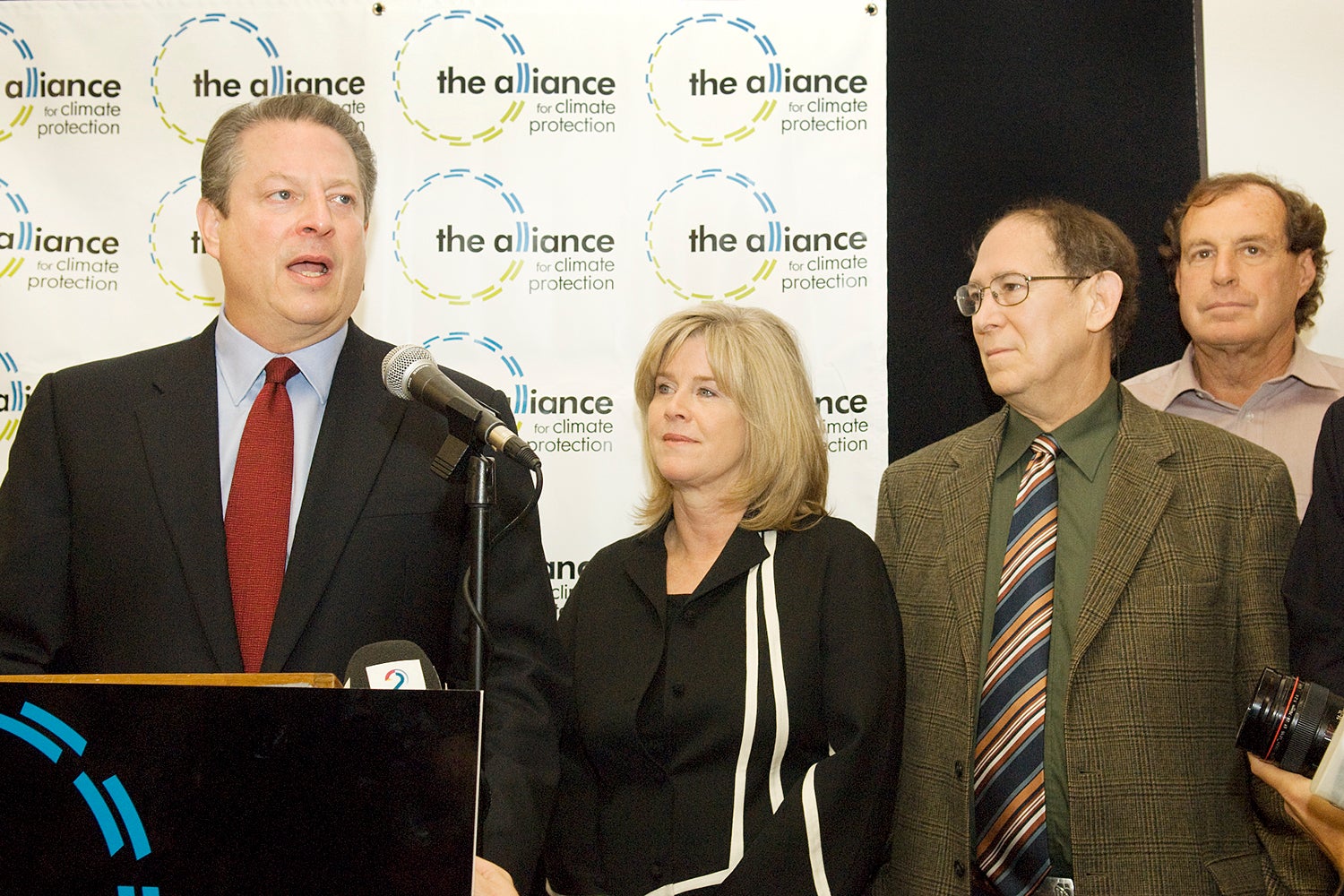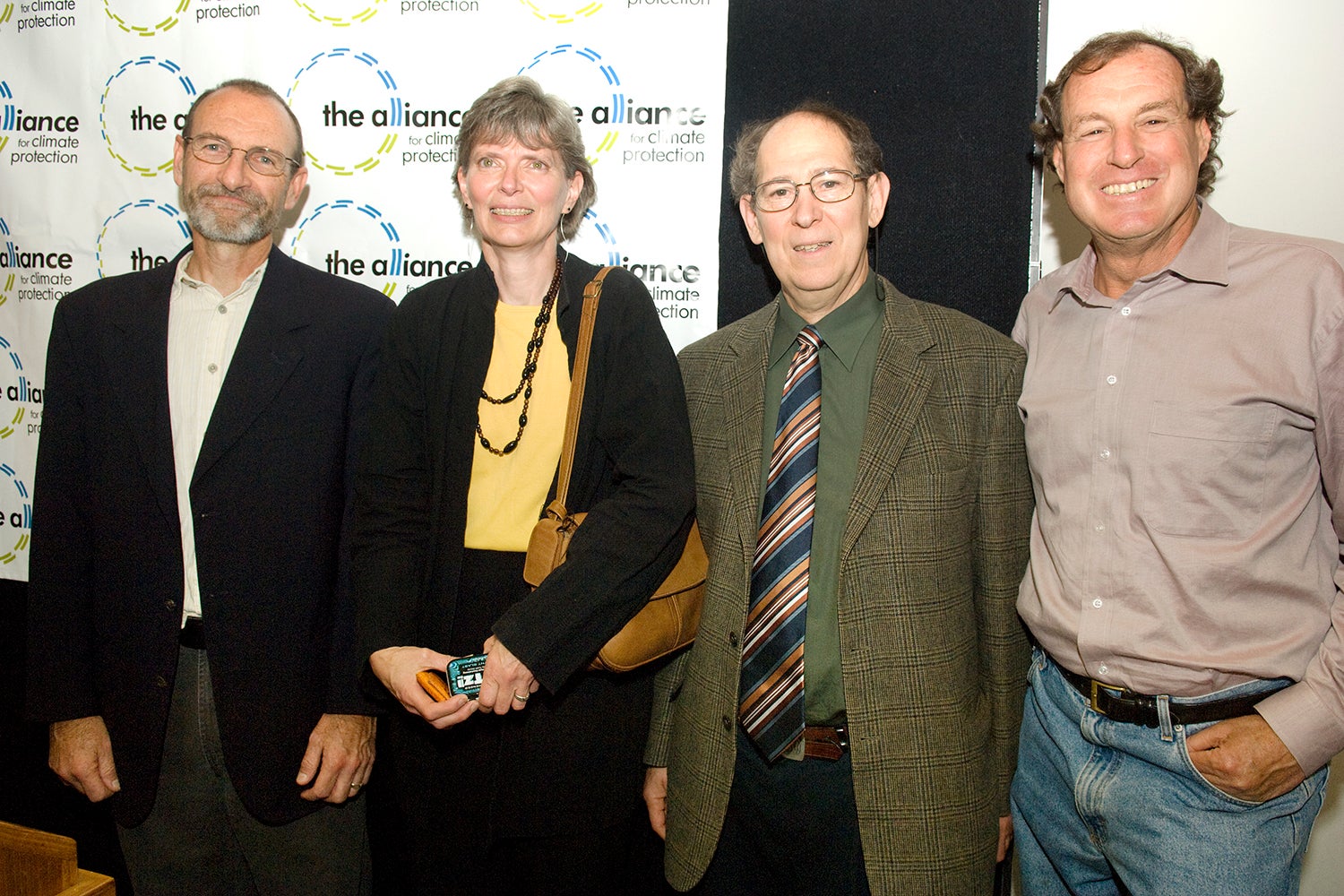Stanford researchers made key contributions to Nobel-winning climate panel
Stephen Schneider, Terry Root, Chris Field and Thomas Heller are among the roughly 2,000 scientists and policy experts from around the world who have made contributions to the United Nations' Intergovernmental Panel on Climate Change (IPCC), which shared the 2007 Nobel Peace Prize with the former vice president.
When Al Gore met the press Friday morning in Palo Alto, four Stanford researchers stood by his side.

Al Gore stands with his wife, Tipper, and Stanford Professors Stephen Schneider and Thomas Heller during a press conference Friday at the Alliance for Climate Protection in Palo Alto. The former vice president spoke after learning he would share the Nobel Peace Prize with the United Nations’ Intergovernmental Panel on Climate Change, for which several Stanford scholars, including Schneider and Heller, have worked. (Image credit: L.A. Cicero)
Stephen Schneider, Terry Root, Chris Field and Thomas Heller are among the roughly 2,000 scientists and policy experts from around the world who have made contributions to the United Nations’ Intergovernmental Panel on Climate Change (IPCC), which shared the 2007 Nobel Peace Prize with the former vice president.
Gore had been a favorite to win the prize, but Field, a professor of biological sciences and a member of the panel, said he was “blown away that it went to the IPCC as well.”
The Nobel committee awarded the prize to the IPCC and Gore “for efforts to build up and disseminate greater knowledge about man-made climate change, and to lay the foundations for the measures that are needed to counteract such change.”
Since its founding in 1988 in Geneva, Switzerland, the IPCC has published a series of scientific reports—the consensus of leading researchers from 120 countries—that have “created an ever-broader informed consensus about the connection between human activities and global warming,” according to the Nobel citation. The reports have provided scientific legitimacy to governmental efforts to deal with climate change.
Gore said he was proud to share the award with the IPCC scientists “who have tirelessly and selflessly worked on this for so many years.”

From left: Chris Field, Terry Root, Stephen Schneider and Thomas Heller, who joined Al Gore for his appearance on Oct. 12 at the Alliance for Climate Protection in Palo Alto. The four participated on the United Nations’ Intergovernmental Panel on Climate Change, which shares the 2007 Nobel Peace Prize with Gore. (Image credit: L.A. Cicero)
Schneider, another key Stanford player on the panel, said he heard about the Nobel when he returned home from Wyoming, where he had been “arguing with the coal industry” about carbon dioxide emissions. It was a typical outing for Schneider, who has been studying global warming for four decades. His first congressional testimony on the subject was in 1981 before a committee chaired by Gore.
These Stanford researchers are lead authors of several major IPCC reports:
- Chris Field, professor of biological sciences and director of the Carnegie Institution’s Department of Global Ecology at Stanford;
- Thomas Heller, the Lewis Talbot and Nadine Hearn Shelton Professor of International Legal Studies and senior fellow at the Woods Institute for the Environment and at the Freeman Spogli Institute for International Studies;
- Michael Mastrandrea, research associate at the Woods Institute and lecturer in the School of Earth Sciences;
- Terry Root, senior fellow at the Woods Institute;
- Stephen Schneider, the Melvin and Joan Lane Professor for Interdisciplinary Environmental Studies and senior fellow at the Woods Institute;
- John Weyant, professor (research) of management science and engineering.
An expert on the effects of climate change on North America, Field said that Stanford has played an instrumental role in the work of the IPCC.
His own research includes experiments at the Jasper Ridge Biological Preserve, a 1,189-acre research site in the foothills west of the main campus, where the environment of an outdoor meadow can be altered (by using heaters to raise the temperature, for example) to help predict the future of a warmer Earth.
He noted that the symptoms of warming are already being seen in heat waves, increased forest fires, fierce hurricanes and sea-level change.
“Climate change expresses itself in extreme events,” he said.
Root, who was editor of an IPCC report, said shaping every sentence to win a consensus of the international community was not easy. “It’s very difficult. It takes a lot of effort,” she said.
Mark Shwartz, communications manager at the Woods Institute for the Environment, contributed to this article.
